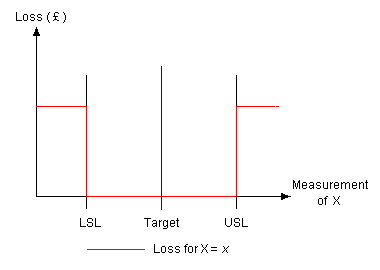As we said In the Beginning..., the notion of specifications as goalposts allows for, even enforces a highly polarised world view. A piece of product is either good, or it is bad, and the division between these two is sudden and sharp. What happens if we introduce the concept of loss into this world view? If we define loss as the cost associated with a particular measurement of a quality characteristic X, we can plot a graph of the way loss has traditionally been perceived.  What we end up with is known as a step function, where at some arbitrary cut-off point the perceived loss changes abruptly from one level to another. Because all of the output which falls within the specification limits is assumed to be uniformly good, there is no way of distinguishing between any two pieces, no matter how broad the range between the limits might be. Thus at any given value x for the characteristic X, the associated loss is perceived to be either non-existent, or total. To make things a little more concrete, consider the step loss function for a steel rolling operation. The specifications for the thickness of the finished sheets are 15mm ±2mm. Using the traditional approach, a sheet of thickness of 13.1mm may be followed by one of thickness 16.9mm without anyone becoming unduly concerned. If, however, the second sheet has a thickness only 0.2mm lower, at 12.9mm, the manufacturer must assume the cost of scrapping the sheet, and thus a loss is perceived.  Can we honestly believe that the quality of the product at 12.9mm is so very different from that at 13.1mm? |